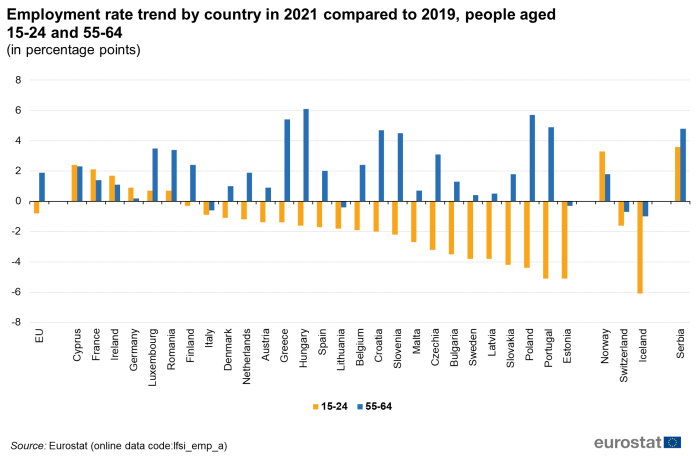Demo - Dominique - GOPA
Senior versus youth employment
The structure of the EU labour market changed significantly over the 12-year period between 2009 and 2021. The previous section of this article already highlighted the increasing share of employed women over time. Another relevant finding is the growing share of employed people aged 55-64 and the decreasing share of employed people aged 15-24. People aged 55-64 accounted for 12.5 % of total employed people aged 15-64 in 2009 rising to 19.0 % of the total in 2021. Almost 1 in 10 employed people (9.2 %) were aged between 15 and 24 years in 2009 whereas their share fell to 7.8 % in 2021 (see attached Excel file for related data).
Figure 3 displays the employment rate trend by age group and sex. It clearly shows that the employment rate varies significantly from one category to another. First, in 2021, 30.3 % of young women and 35.0 % of young men aged 15-24 were employed in the EU. In the same year, 85.7 % of men aged 25-54 were employed, while women aged 25-54 had an employment rate of 75.1 %. For people aged 55-64, almost two thirds of men (67.0 %) were employed against 54.3 % of women in the same age group. The older the people, the wider the gender employment gap.

(in % of the total population)
Source: Eurostat (lfsi_emp_a)
The long-term trend shows that the employment of people aged 55-64 records an upward trend globally and fluctuates less than for younger people, even when the COVID-19 pandemic hit the labour market in 2020. Over the 12-year period from 2009 to 2021, the employment rate of women aged 55-64 recorded a sharp increase of 19.1 pp. The increase was also substantial for men aged 55-64 (+15.0 pp). The employment rate went up by 4.9 pp for women and by 2.5 pp for men aged 25-54. The smallest increases in the employment rate were recorded by young men and women (+0.2 pp for both sexes).
Figure 3 also highlights the impact of the health crisis on employment, specifically on youth employment:
- The employment rate fell by around 2 pp for young men and women between 2019 and 2020. It failed to recover to the pre-pandemic level in 2021 and was still around 1.2 pp below the 2019 value. The article on Employment - quarterly statistics contains further information on the type of employment among young people, e.g. the high number of temporary contracts for this age group.
- Employment of men aged 25-54 reached its pre-pandemic level in 2021, while the employment rate of women in the same age group was 0.5 pp higher in 2021 than in 2019.
- The share of employed people aged 55-64 increased by 2.0 pp for women and by 1.7 pp for men from 2019 to 2021.
In 2021, the employment of young people had fully recovered from the COVID-19 pandemic in only 6 EU countries: Cyprus, France, Ireland, Germany, Luxembourg and Romania (see Figure 4). In these countries, the employment rate in 2021 reached or exceeded the pre-pandemic level. By contrast, the 2021 rate in Portugal and Estonia was still around 5 pp below its 2019 level. The picture is significantly different for senior employment: only 3 out of 27 EU Member States recorded an employment rate lower in 2021 than in 2019, namely Italy, Lithuania and Estonia.

(in percentage points)
Source: Eurostat (lfsi_emp_a)
<sesection>
Employment rate by level of education
The level of educational attainment significantly affects the employment rate (see Tool 2 and Figure 5). The employment rate of people (aged 20-64) who had completed a high level of education was 85.0 % for the EU in 2021. This was much higher than the rate for those who have only attained a low education level, which was 54.9 % for the EU. It is worth noting that a high level of educational attainment refers to short-cycle tertiary, bachelor’s, master’s or doctoral levels (or equivalents; ISCED levels 5-8), while a low level refers to primary or lower secondary education (ISCED levels 0-2). The EU employment rate of people who have completed their education to a medium level, i.e. an upper secondary or post-secondary non-tertiary education (ISCED levels 3-4), was between the two previous rates in 2021, at 72.8 %. Consequently, the higher the educational attainment level, the higher the employment rate. All EU Member States followed this pattern in 2021, albeit to a different extent, as shown in Figure 5.

(in % of the total population aged 20-64, sorted by descending order on the low level)
Source: Eurostat (lfsi_emp_a)
As well as being the least likely to get a job (among the 3 education level groups), people with a low educational attainment level recorded the slowest employment rate increase between 2009 and 2021 (+2.3 pp). The corresponding increases over the same period for those with a medium or high level of educational attainment were +3.7 pp and +2.5 pp respectively.
The employment rate in 2021 was still below its pre-pandemic level (in 2019) for people with a low level (-0.1 pp) and for those with a medium level (-0.2 pp) but was above its pre-pandemic level for those with a high level of educational attainment (+0.2 pp) (see Tool 2).